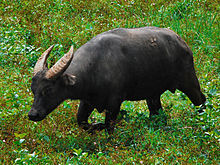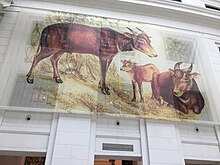
Anoa, also known as dwarf buffalo and sapiutan, are two species of the genus Bubalus, placed within the subgenus Anoa and endemic to the island of Sulawesi in Indonesia: the mountain anoa and the lowland anoa. Both live in undisturbed rainforests and are similar in appearance to miniature water buffaloes, weighing 150–300 kg (330–660 lb).
Buffalo most commonly refers to:

The water buffalo, also called the domestic water buffalo or Asian water buffalo, is a large bovid originating in the Indian subcontinent and Southeast Asia. Today, it is also found in Italy, the Balkans, Australia, North America, South America and some African countries. Two extant types of water buffalo are recognized, based on morphological and behavioural criteria: the river buffalo of the Indian subcontinent and further west to the Balkans, Egypt and Italy and the swamp buffalo, found from Assam in the west through Southeast Asia to the Yangtze Valley of China in the east.

Bovines comprise a diverse group of 10 genera of medium to large-sized ungulates, including cattle, bison, African buffalo, water buffalos, and the four-horned and spiral-horned antelopes. The evolutionary relationship between the members of the group is still debated, and their classification into loose tribes rather than formal subgroups reflects this uncertainty. General characteristics include cloven hooves and usually at least one of the sexes of a species having true horns. The largest extant bovine is the gaur.

Bubalus is a genus of Asiatic bovines that was proposed by Charles Hamilton Smith in 1827. Bubalus and Syncerus form the subtribe Bubalina, the true buffaloes.

Mindoro is the seventh largest and eighth-most populous island in the Philippines. With a total land area of 10,571 km2 and has a population of 1,408,454 as of 2020 census. It is located off the southwestern coast of Luzon and northeast of Palawan. Mindoro is divided into two provinces: Occidental Mindoro and Oriental Mindoro. San Jose is the largest settlement on the island with a total population of 143,430 inhabitants as of 2015. The southern coast of Mindoro forms the northeastern extremum of the Sulu Sea. Mount Halcon is the highest point on the island, standing at 8,484 feet (2,586 m) above sea level located in Oriental Mindoro. Mount Baco is the island's second highest mountain with an elevation of 8,163 feet (2,488 m), located in the province of Occidental Mindoro.
The Cebu tamaraw is a fossil dwarf buffalo discovered in the Philippines, and first described in 2006.
Habitat: The Mindoro scops owl is an owl that is native to the Mindoro island in the Philippines. They live in a terrestrial environment and their main habitat consists of the highly elevated forests with a very small global range Meaning they do not migrate or have movement patterns. The ongoing clearance of forest habitats has slightly affected their habitat. As of October 1, 2016, the Mindoro Scops Owl species has been labeled to be a newly threatened species, or critically endangered species. For instance, the Montane forest has been almost completely cleared out by logging operations, which may pose a threat to this species.
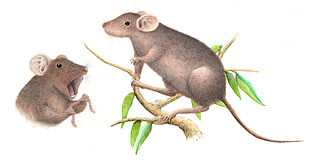
The large Mindoro forest mouse is a species of rodent in the family Muridae, from the genus Apomys. It is found only in the Philippines. Its natural habitat is subtropical or tropical moist montane forests. It is a large mouse with large feet, a long tail and an elongated snout which is morphologically unique within its genus. It is covered in soft fur which is mostly dark brown in colour. Its closest relative is thought to be the Luzon montane forest mouse, based on genetic and morphological similarities.

The Mindoro hornbill is a species of hornbill in the family Bucerotidae. It is endemic to forests on Mindoro in the Philippines found in tropical moist lowland forests. As is the case with all Philippine tarictic hornbills, it was once considered a subspecies of P. panini. It is the only tarictic hornbill where both sexes are creamy-white and black. The sexes are very similar, differing primarily in the colour of the ocular ring. It is threatened by habitat loss, and is consequently considered endangered by the IUCN.
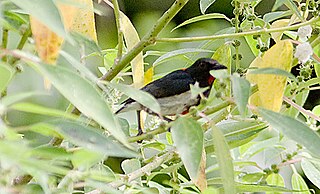
The scarlet-collared flowerpecker is a species of bird in the family Dicaeidae, about 10 cm long and is endemic to the Philippines.
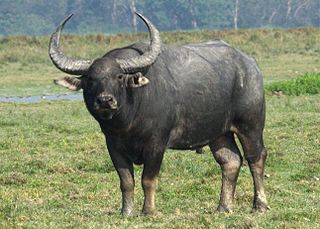
The wild water buffalo, also called Asian buffalo, Asiatic buffalo and wild buffalo, is a large bovine native to the Indian subcontinent and Southeast Asia. It has been listed as Endangered in the IUCN Red List since 1986, as the remaining population totals less than 4,000. A population decline of at least 50% over the last three generations is projected to continue. The global population has been estimated at 3,400 individuals, of which 3,100 (91%) live in India, mostly in Assam. The wild water buffalo is the most likely ancestor of the domestic water buffalo.

The tribe Bovini or wild cattle are medium to massive bovines that are native to Eurasia, North America, and Africa. These include the enigmatic, antelope-like saola, the African and Asiatic buffalos, and a clade that consists of bison and the wild cattle of the genus Bos. Not only are they the largest members of the subfamily Bovinae, they are the largest species of their family Bovidae. The largest species is the gaur, weighing up to 1,500 kg (3,300 lb).

The Mounts Iglit–Baco Natural Park (MIBNP) is a legislated protected area of the Philippines and an ASEAN Heritage Park located in the island of Mindoro in the central Philippines. It was first established in 1970 by virtue of Republic Act No. 6148 as a national park that covered an area of 75,445 hectares surrounding Mount Iglit and Mount Baco in the interior of Mindoro. The park is the home of the largest remaining population of the critically endangered tamaraw. In 2003, the Association of Southeast Asian Nations listed it as one of its four heritage parks in the Philippines. The park has also been nominated to the Tentative List of UNESCO World Heritage Sites in 2006. In 2018, the park was designated as a "Natural Park" under the Republic Act No. 11038 or the Expanded National Integrated Protected Areas Systems (ENIPAS) Act of 2018, which increased the area to 106,656 hectares.

The mountain anoa(Bubalus quarlesi) also known as Quarle's anoa, is a species of buffalo endemic to Sulawesi. Its closest relative is the lowland anoa, and it is still a debate as to whether the two are the same species or not. It is also related to the water buffalo, and both are classified in the genus Bubalus.
The Mindoro boobook or Mindoro hawk-owl is a species of owl in the family Strigidae that is endemic to the Philippines.

The lowland anoa(Bubalus depressicornis) is a species of buffalo endemic to Sulawesi. Its closest relative is the mountain anoa, and it is still a debate as to whether the two are the same species or not. It is also related to the water buffalo, and both are classified in the genus Bubalus.
The Mindoro racket-tail is a species of parrot in the Psittaculinae family. It was formerly considered conspecific with the blue-crowned racket-tail. It is endemic to the island of Mindoro in the Philippines and it occurs in tropical moist lowland forest. It is threatened by habitat loss and trapping for the cage-bird trade.
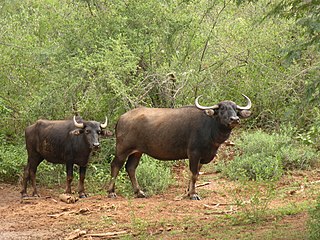
Bubalina is a subtribe of wild cattle that includes the various species of true buffalo. Species include the African buffalo, the anoas, and the wild water buffalo. Buffaloes can be found naturally in sub-Saharan Africa, South Asia and Southeast Asia, and domestic and feral populations have been introduced to Europe, the Americas, and Australia. In addition to the living species, bubalinans have an extensive fossil record where remains have been found in much of Afro-Eurasia.

The Mindoro rain forests ecoregion covers the island of Mindoro, which lies between the island of Luzon and the Palawan Archipelago in the Philippines. The island has been subject to heavy commercial logging, with the only original forests remaining on the high ridge of the central mountain range. Logging has been reduced long enough on the east side of the mountains to support a regrown forest and a number of endemic species.
